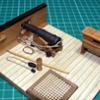-
Posts
5,939 -
Joined
-
Last visited
Content Type
Profiles
Forums
Gallery
Events
Everything posted by BANYAN
-
That is looking great Michael; and agree with Druxey, the joinery is very good. cheers Pat
- 2,215 replies
-

HMCSS Victoria 1855 by BANYAN - 1:72
BANYAN replied to BANYAN's topic in - Build logs for subjects built 1851 - 1900
Thanks OC, things have slowed a little lately while I do more research and produce some parts (and a road trip of 10 days departing Monday coming) Hope to do some work on my Vampire on return also. cheers- 1,006 replies
-
- gun dispatch vessel
- victoria
-
(and 2 more)
Tagged with:
-
Nice 'bodging' Rob, looks functional and appropriate at the scale you are working cheers Pat
- 1,208 replies
-
- great republic
- clipper
-
(and 1 more)
Tagged with:
-
Great idea Rob; I look forward to seeing how these turn out. cheers Pat
- 1,208 replies
-
- great republic
- clipper
-
(and 1 more)
Tagged with:
-

H.M.S. Atalanta - Drafting my own plans
BANYAN replied to Ben752's topic in CAD and 3D Modelling/Drafting Plans with Software
Very clear Rick cheers Pat -

HMCSS Victoria 1855 by BANYAN - 1:72
BANYAN replied to BANYAN's topic in - Build logs for subjects built 1851 - 1900
Thanks Tecko; appreciate you looking in and commenting. cheers Pat- 1,006 replies
-
- gun dispatch vessel
- victoria
-
(and 2 more)
Tagged with:
-
Even with the 'tails' to be docked you can see the quality of the rigging and fittings ED; really like those spider bands. cheers Pat
- 3,618 replies
-
- young america
- clipper
-
(and 1 more)
Tagged with:
-
Thanks for looking Joss. WRT footropes, I soaked mine in diluted PVA and shaped them as they dried; might be worth a try? cheers Pat
- 38 replies
-
- bounty
- caldercraft
-
(and 1 more)
Tagged with:
-
You did a very fine restoration on that model Michael and I am sure it will always be a great memory. That workshop look great with plenty of natural light. cheers Pat
- 749 replies
-
- albertic
- ocean liner
-
(and 2 more)
Tagged with:
-
Quite the production run GL; look forward to the hull coming together. cheers Pat
- 219 replies
-
- smack
- cross-section
-
(and 2 more)
Tagged with:
-
A pleasure to meet you the other night Tim and see this little beauty; you have done a great job on her. cheers Pat
- 115 replies
-
- Scottish Maid
- artesania latina
-
(and 1 more)
Tagged with:
-

Shipyard Card Model - Rigging Materials
BANYAN replied to Richmond's topic in Masting, rigging and sails
Richmond, also try Float-A-Boat in Melbourne for scale rope; they have a range. Also, you could try Modellers Central (ex Modellers Shipyard in Sydney. cheers Pat -
Excellent work as usual Ed; appreciate the tips on the processes involved. cheers Pat
- 3,618 replies
-
- young america
- clipper
-
(and 1 more)
Tagged with:
-
All looking good there Rob; keep pluggin' along cheers Pat
- 1,208 replies
-
- great republic
- clipper
-
(and 1 more)
Tagged with:
-
That's what it is all about Rod - live and learn looks good. cheers Pat
- 108 replies
-
- endeavour
- caldercraft
-
(and 1 more)
Tagged with:
-
Nice work OC, she came up a treat. Make sure you find 'pride of place' on the display stand for her eventually. cheers Pat
-
She is looking good; and what a great way to show her off! cheers Pat
- 1,208 replies
-
- great republic
- clipper
-
(and 1 more)
Tagged with:
-
They look terrific Ed, a great technique (another I will 'steal' from you cheers Pat
- 3,618 replies
-
- young america
- clipper
-
(and 1 more)
Tagged with:
-
Very nice progress there mate with a great recovery on those pin racks. The backdrop works well and really allow some better representation of the colour to be shown. cheers Pat
- 108 replies
-
- endeavour
- caldercraft
-
(and 1 more)
Tagged with:
About us
Modelshipworld - Advancing Ship Modeling through Research
SSL Secured
Your security is important for us so this Website is SSL-Secured
NRG Mailing Address
Nautical Research Guild
237 South Lincoln Street
Westmont IL, 60559-1917
Model Ship World ® and the MSW logo are Registered Trademarks, and belong to the Nautical Research Guild (United States Patent and Trademark Office: No. 6,929,264 & No. 6,929,274, registered Dec. 20, 2022)
Helpful Links
About the NRG
If you enjoy building ship models that are historically accurate as well as beautiful, then The Nautical Research Guild (NRG) is just right for you.
The Guild is a non-profit educational organization whose mission is to “Advance Ship Modeling Through Research”. We provide support to our members in their efforts to raise the quality of their model ships.
The Nautical Research Guild has published our world-renowned quarterly magazine, The Nautical Research Journal, since 1955. The pages of the Journal are full of articles by accomplished ship modelers who show you how they create those exquisite details on their models, and by maritime historians who show you the correct details to build. The Journal is available in both print and digital editions. Go to the NRG web site (www.thenrg.org) to download a complimentary digital copy of the Journal. The NRG also publishes plan sets, books and compilations of back issues of the Journal and the former Ships in Scale and Model Ship Builder magazines.


